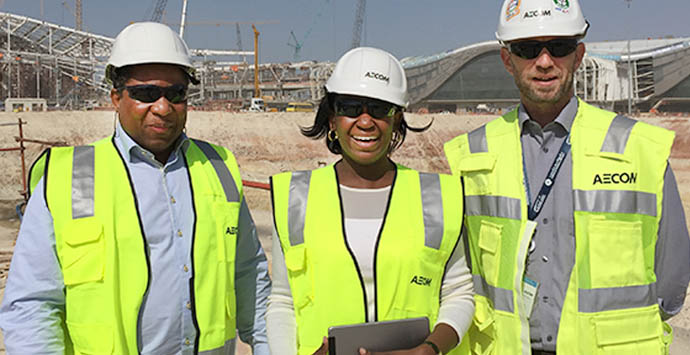#WomenExcel: Breaking the mould
Celebrated globally on March 8, International Women’s Day recognizes the social, economic, cultural and political achievements of women. AECOM has devoted the Impact blog to featuring women leaders across the globe throughout the month of March. Join us here as we recognize the accomplishments of our staff around the world, embrace diversity and promote gender parity.
I was born in Uganda to parents who were trailblazers in their own right. My grandfather completed his degree at the then-named Makerere College in the 1950s. My father, who had never left Uganda in his life, earned four university scholarships and chose to study dentistry in the U.K. My mother was accepted into medical school in 1977, one of just a handful of women selected. As a result, I grew up in a home where taking risks to achieve goals was encouraged. The first Christmas present I remember receiving was at the age of 3 — a first aid kit with a pink stethoscope to match.
I’m inspired by those who have broken barriers in design, innovation and human capability. These individuals have walked a road less travelled and are encouraged by the endless possibilities of what we can do when we don’t place limitations on ourselves.
AECOM has given me the opportunity to merge my specialized skills and expertise. From dreary car counting to managing major project delivery, my work has allowed me to grow into an analytical thinker able to interpret complex data, draw meaningful conclusions and make business recommendations that enhance project delivery. Externally, I have been intrinsically involved in South Africa’s broader transport industry in several strategic capacities and currently serve as a board/committee member for a number of transport organizations and structures in the country.
I am an avid believer in leaving a legacy in all that I do, so I am passionate about the social and developmental aspects of infrastructure project delivery in AECOM’s Africa business. For example, one way a major program can address sustainable project delivery is by focusing on local content programs. These programs are implemented by executing strategies that incorporate training and development opportunities for communities and local businesses, while delivering world-class infrastructure. I believe these types of projects leave a lasting impression on the public.
 Midfield Terminal Complex project, Abu Dhabi Airport. From left to right: Dede Bukasa, end market lead, civil & infrastructure, Africa; Bridget Ssamula; and Craig Campbell, director, construction, United Arab Emirates.
Midfield Terminal Complex project, Abu Dhabi Airport. From left to right: Dede Bukasa, end market lead, civil & infrastructure, Africa; Bridget Ssamula; and Craig Campbell, director, construction, United Arab Emirates.
While I agree that we are seeing great progress in advancing global gender parity in our boardrooms, offices and workplaces (particularly in the service industry), we still have a ways to go in terms of providing enhanced flexibility to work schedules and options for working parents. My biggest challenge has been overcoming limitations others have imposed on my potential based on their perceptions of gender and culture in the workplace — an obstacle that I believe can impact our career choices.
However, I did not let that get in the way of my pursuit of an engineering career. In my first training session, the resident engineer implied that I should have stayed in the office doing administrative work, but after I walked more than 60 kilometres (37.3 miles) measuring the volume of potholes on a “gravel road upgrade,” I think he changed his mind. My responsibility is to continue breaking the mould for women who dream of entering the technical work space, like those who have walked this path before did for me.
 Bridget Ssamula is a market sector lead in aviation and rail in Uganda with more than 11 years of experience in transportation projects. She has specialist skills in strategic planning, transportation network design, costing and optimisation as well as in transport operations planning and modelling. Bridget has also worked in research and academia and in operations at all levels of project delivery. She has received numerous industry awards and has authored of a variety of peer-reviewed conference papers, technical papers and mainstream articles.
Bridget Ssamula is a market sector lead in aviation and rail in Uganda with more than 11 years of experience in transportation projects. She has specialist skills in strategic planning, transportation network design, costing and optimisation as well as in transport operations planning and modelling. Bridget has also worked in research and academia and in operations at all levels of project delivery. She has received numerous industry awards and has authored of a variety of peer-reviewed conference papers, technical papers and mainstream articles.
LinkedIn: Bridget Ssamula






